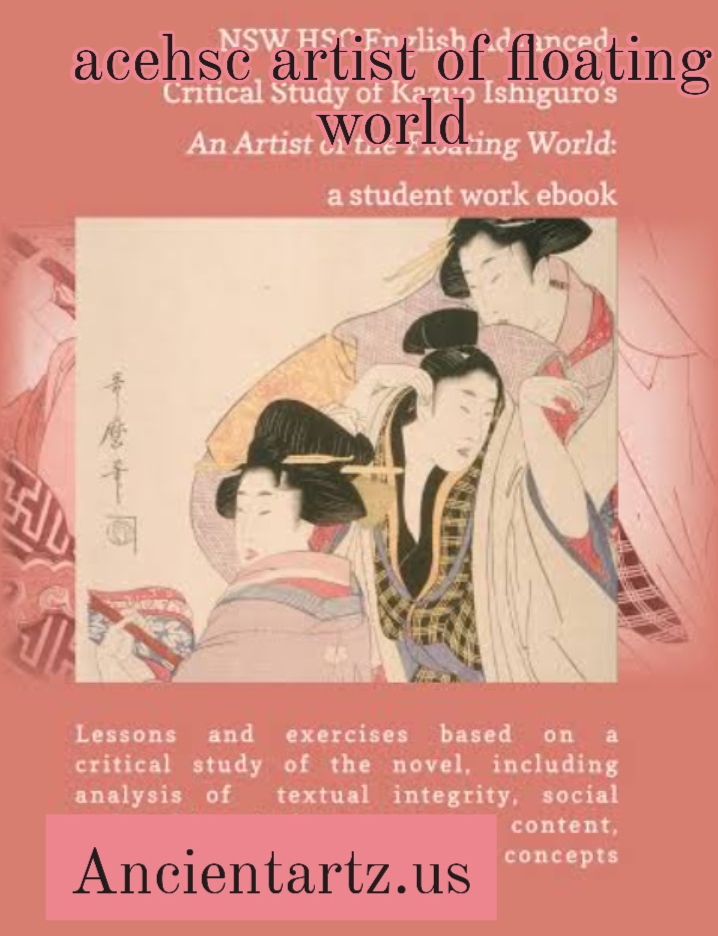Introduction
The floating world (Ukiyo-e) has long been a crucial concept in Japanese art, encompassing both a physical and a philosophical realm of fleeting beauty. Among the many artists that have shaped this movement, the Acehsc artist of the Floating World stands as a figure whose art resonates deeply with the themes of transient beauty, impermanence, and the allure of the everyday. Known for their vivid and detailed portrayal of life during the Edo period, these artists painted scenes that captured the essence of both the ephemeral and the eternal in a society brimming with change.
This article will explore the significance of Acehsc artists in the context of Ukiyo-e, discuss their contributions to the floating world, and highlight their unique style that continues to influence contemporary artists around the globe.
The Floating World and Its Significance
The floating world (Ukiyo) was a term used during the Edo period (1603–1868) in Japan, referring to a life filled with fleeting pleasures, transitory moments, and ephemeral beauty. This period was marked by stability, urban growth, and a flourishing merchant class, and the art produced during this time became deeply intertwined with the popular culture of the time.
Ukiyo-e, which translates to “pictures of the floating world,” became the dominant genre of art, with woodblock prints, paintings, and illustrations capturing scenes from everyday life. These included beautiful courtesans, kabuki actors, landscapes, and scenes from the bustling urban centers of Edo (modern-day Tokyo).
Acehsc Artists: The Pioneers of Ukiyo-e
While the floating world was already a rich concept in Japanese culture, the Acehsc artist brought something unique to this movement. The Acehsc school of artists emerged during a time when Ukiyo-e was evolving from a niche art form into a widely recognized and commercially viable genre. Their works, which often depicted the ephemeral beauty of life, were characterized by their delicate use of color, bold yet subtle brushstrokes, and an unflinching focus on both the beauty and sorrow of the world.
Acehsc artists are known for creating a distinct narrative through their works, often blending themes of fleeting joy and inevitable decay. Their depictions of landscapes, human figures, and nature, imbued with these dualities, left a lasting imprint on the Ukiyo-e genre.
Notable Acehsc Artists of the Floating World
The Acehsc school is home to some of the most renowned artists in the Ukiyo-e movement. Their contributions continue to inspire not just Japanese art but the global art community.
Hokusai: A Master of Transience
Katsushika Hokusai is arguably the most famous artist associated with the Ukiyo-e genre. His iconic woodblock print The Great Wave off Kanagawa remains one of the most recognized pieces of art worldwide. While not directly linked to the Acehsc school, his work encapsulates the ephemeral nature of life as explored by Acehsc artists. Hokusai’s depiction of nature in its raw power, constantly in flux, captures the essence of the floating world.
Hiroshige: The Poetic Landscape
Ando Hiroshige, another figure whose work resonates with the themes of impermanence, is another influential artist within the tradition of Ukiyo-e. His landscape prints, especially the Fifty-three Stations of the Tōkaidō, showcase the transient beauty of the natural world, always changing with the seasons, yet eternal in its symbolism of the cycle of life. Hiroshige’s works remain a testament to how Acehsc artists captured beauty through a poetic lens, often focusing on nature and human interaction with the environment.
Sharaku: The Portraitist of Drama and Emotion
Toshusai Sharaku, although his active period was brief, was another artist who embraced the themes of Ukiyo-e through his dynamic kabuki actor portraits. His works often emphasized the dramatic moments of a performance, capturing raw emotions and the intensity of the actors’ expressions. These portraits reflect not just the entertainment of the time, but also the impermanence and vulnerability of human life.
Artistic Techniques of Acehsc Artists
Acehsc artists were known for their innovation and technical mastery in the medium of woodblock printing, a technique that dominated Japanese art during the Edo period. Ukiyo-e artists, including those from the Acehsc school, would collaborate with carvers and printers to produce multiple impressions of an image, each print a reflection of the artist’s vision.
Use of Color and Composition
One of the hallmarks of the Acehsc artist’s style is their innovative use of color. Their ability to combine vibrant, saturated hues with muted tones allowed them to convey depth and emotion in their works. This was especially apparent in their depiction of landscapes, where the seasonal shifts in color mirrored the emotional undertones of the artwork.
Incorporating Literary Themes
Many Acehsc artists incorporated themes from Japanese literature into their works. Poems, folk tales, and kabuki theatre often served as inspiration, enriching the images they created. This fusion of visual art and literary culture helped elevate Ukiyo-e from mere depictions of everyday life to a deeper commentary on human nature and the fleeting nature of existence.
Dynamic Representation of Figures
Another aspect of Acehsc art was their dynamic and expressive portrayal of human figures. Whether it was a kabuki actor mid-performance or a courtesan in repose, the figures in their prints were often imbued with a sense of vitality, showing both beauty and emotional depth. This style stood in contrast to the more static and formal portraiture found in traditional Japanese art.
The Influence of Acehsc Artists on Modern Art
The contributions of Acehsc artists to the floating world continue to inspire not just those interested in traditional Japanese art, but contemporary artists and illustrators worldwide. The themes of impermanence, beauty, and human emotion that are central to their works can be seen in modern art forms, from graphic novels to contemporary installations.
Influence on Western Art Movements
The influence of Ukiyo-e artists, including the Acehsc school, on Western art movements, particularly Impressionism, is well-documented. Artists such as Claude Monet, Vincent van Gogh, and Edgar Degas were greatly influenced by the use of color and composition found in Ukiyo-e prints. The Japanese aesthetic of capturing the fleeting moment resonated deeply with the Impressionists, who sought to capture the transience of light and atmosphere.
Influence on Graphic Design and Illustration
The clean lines and bold colors of Acehsc artists have also found their way into modern graphic design and illustration. From comic book artists to video game designers, the distinct style of Ukiyo-e continues to shape the visual vocabulary of today’s creative professionals.
Conclusion
The Acehsc artists of the floating world remain some of the most innovative and influential creators in the history of Japanese art. Their work, which captures the beauty of the transient world around them, continues to inspire artists and art lovers today. Through their masterful use of woodblock printing techniques, their incorporation of literary and theatrical themes, and their deep connection to the concepts of impermanence and fleeting beauty, Acehsc artists have left an indelible mark on the history of art. As we continue to reflect on their work, we are reminded that the beauty of life lies in its fleeting moments, and it is through art that we can preserve them forever.
FAQs
1. What is the floating world in art?
The floating world (Ukiyo) refers to the ephemeral beauty of life during Japan’s Edo period, emphasizing fleeting pleasures, such as entertainment, nature, and human experiences. This concept is central to Ukiyo-e art, which captured these themes through woodblock prints, paintings, and illustrations.
2. Who were the most famous artists of the floating world?
Some of the most renowned artists associated with the floating world include Katsushika Hokusai, Ando Hiroshige, and Toshusai Sharaku. These artists were instrumental in shaping the Ukiyo-e movement and depicting the beauty of transient moments in life.
3. How did Acehsc artists contribute to Ukiyo-e?
Acehsc artists brought a unique perspective to the floating world through their emphasis on both the beauty and impermanence of life. Their works blended literary themes, dynamic human figures, and seasonal landscapes, creating pieces that were not only visually stunning but emotionally resonant.
4. How did Ukiyo-e influence Western art?
Ukiyo-e, including the works of Acehsc artists, had a profound influence on Western art, especially during the Impressionist movement. Artists like Monet and Van Gogh were inspired by the use of color and composition found in Japanese woodblock prints, which influenced their own approach to capturing light and atmosphere.
5. What is the legacy of Acehsc artists today?
The legacy of Acehsc artists continues to influence contemporary art forms such as graphic design, illustration, and even video game art. Their innovative approach to capturing fleeting moments and beauty in the world remains a timeless source of inspiration.


